by: Zack Muindre November 8th, 2022 comments:
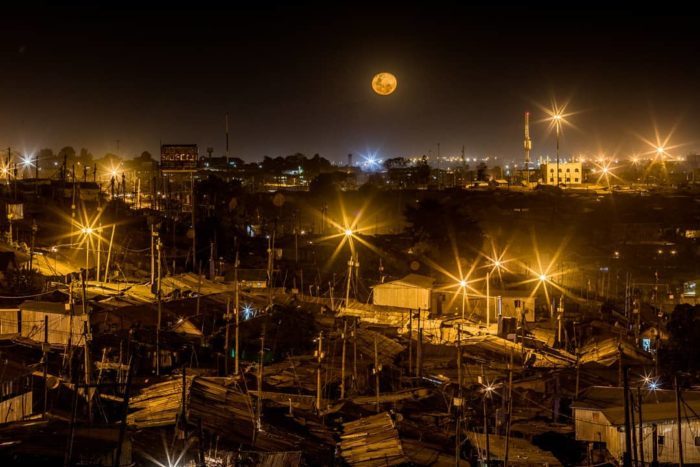
The moon rises above the sky in Kibera.
Photo by © Bryan Jaybee @storitellah #KiberaStories
While a lot of efforts have been put in place to light up Kibera, the question that is on every Kibera resident is whether the effort in place is enough to curb the issues of insecurity during the night. Most of the Kibera residents are casual labourers, most working in the industrial area of the city. The rest are either running their small business within the area and others run small groceries that have their pick time in the evening when everyone comes back and needs to grab something for the evening before calling it a day. All these sectors can only thrive if the security of the area is well improved and this can be achieved when various factors are considered such as increase of security patrol by the police, adequate installation of security lights, lighting up dark allies and lastly community policing.
Here I will concentrate more on the second factor that focuses on the adequate installation of security lights in the area. As I started by saying, a lot of initiatives have been carried out in the area to light up the area. This ranges from the adopt a light project that was initiated by the current women representative of Nairobi Hon Esther Passaris. This was the first of its kind in Kibera and it saw installation of several floodlights in Kibera, which lit the areas very well and the residents were so confident that this would address the issue of insecurity, on the other hand, it also provided light to some of the street vendors who couldn’t afford to stay longer through the night because they couldn’t afford electricity or didn’t have enough money to fuel their lanterns. In 2014 Senegalese singer AKON through his project “Akon Lighting Africa” committed to assisting in lighting up Kibera by funding the installation of more security lights throughout Kibera.
What went wrong?
If you visit Kibera, one of the unique features that you will notice cropping out of the rusty rooftops is the high mast of security lights, but once you get closer then you start noticing something is off with them. You will notice some of the lights are faulty “blinking constantly”, others are still on even during the day, while others are either missing the light bulbs or have none. In other cases some have been vandalized and twisted to face the wrong direction, then we have those whose main switch was also vandalized hence the lights are not working.
While these initiatives were well received by the community, we couldn’t help but notice there are a lot of challenges that have been encountered in the process and that led us to conduct a mapping exercise to understand the scope of the effects.
Security lights mapping
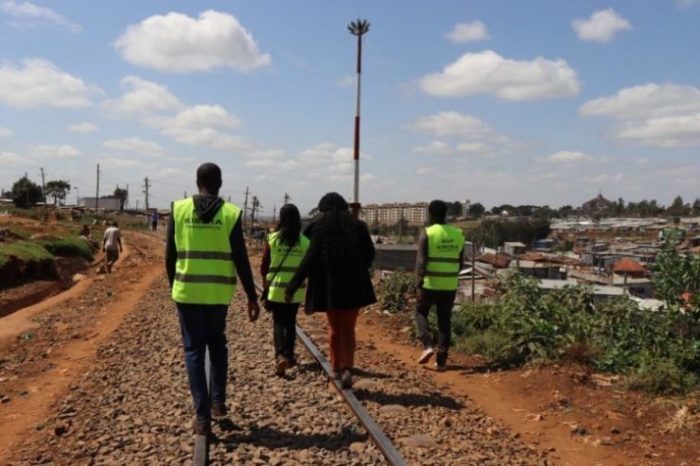
Map Kibera team in the field collecting data.
Mid this year as part of a security mapping project, we planned to revisit some of these sites to update the data that we had collected before. First we checked what we had already and looked for any data gaps that we could collect to create a more substantial case on the issue of insecurity and how it’s linked to how well the areas are lit. After several consultations with various stakeholder we settled on adding the following information:
- Location of the light
- Type of security light
- Who funded the project
- Who does the maintenance of the light
- Who is in charge of operating the light (where it requires one to switch it on)
- What is the source of power
- Number of lights on the pole
- Out of those how many are working
- The colour of the light
- What time does the light switch on
After putting up everything together we rolled out the mapping exercise starting with Fort Jesus estate. The exercise is still ongoing as we had to take breaks in between to work on other things, then followed by the August elections where we put all our efforts into covering the elections. So far we have been able to visit all 13 villages of Kibera and have mapped 431 lights. It has been an interesting exercise where we got to interact with the residents of the area who have openly expressed their concerns and grievances regarding the state of security lights in Kibera such as:
Vandalism
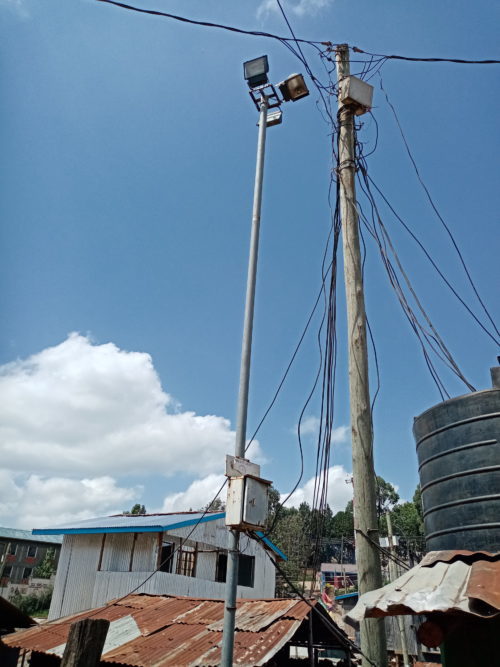
Vandalized streetlight-one of the light bulbs has been stolen.
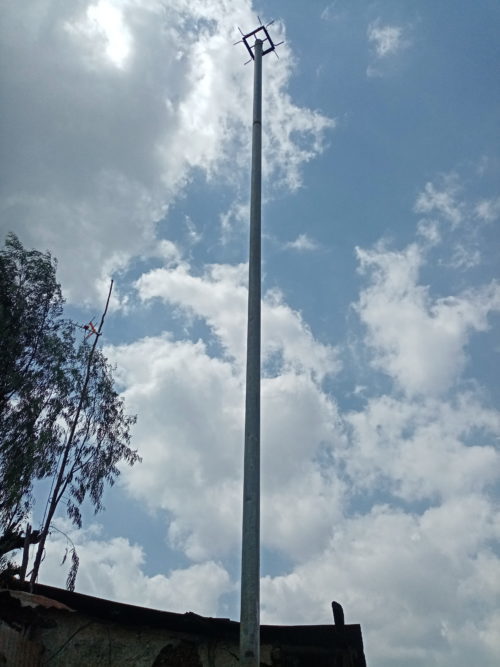
Another vandalized streetlight-all the light bulbs have been stolen.
The government is putting a lot of effort into ensuring there are adequate security lights in Kibera. The exercise has also experienced huge setbacks through vandalism. It’s so clear that there are those in the community whose businesses thrive in darkness and have made every effort to ensure that these security lights don’t interfere with their work. Thugs have intentionally vandalized the lights either by hitting the lights and breaking them or even going to the extent of stealing the lights, how they reach up the light pole is a story for another day. We also notice that not all vandalism is conducted by the so-called thugs, in places where the floodlights were installed some of the residents found a way of tapping the electricity from the main switch and this has caused the lights to break down.
Lack of regular maintenance
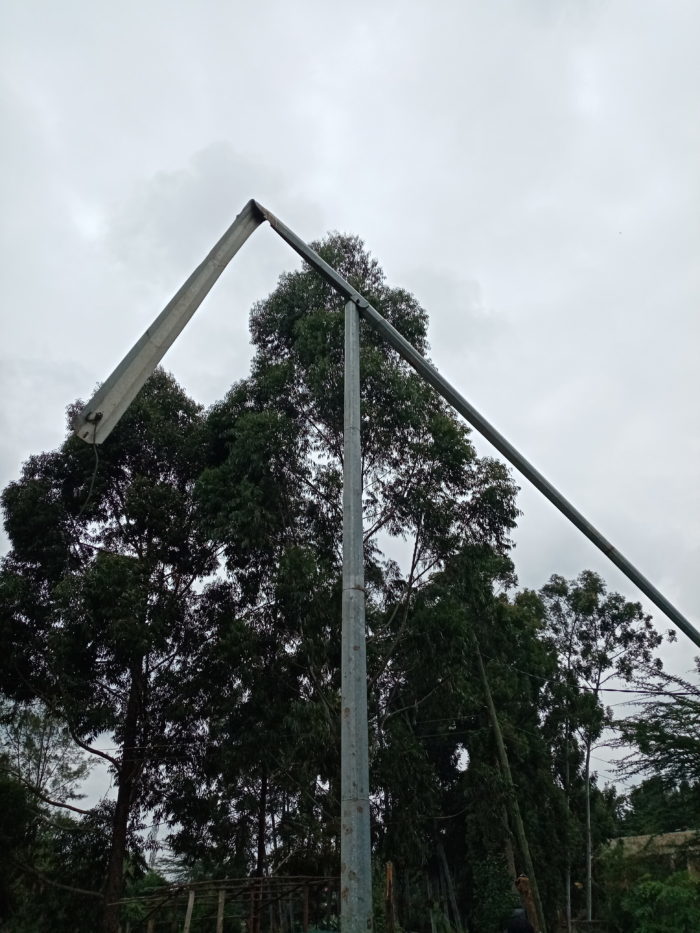
The light has been neglected for months now after it crumbled in the process of installation. According to the local this was a result of using substandard material for the light.
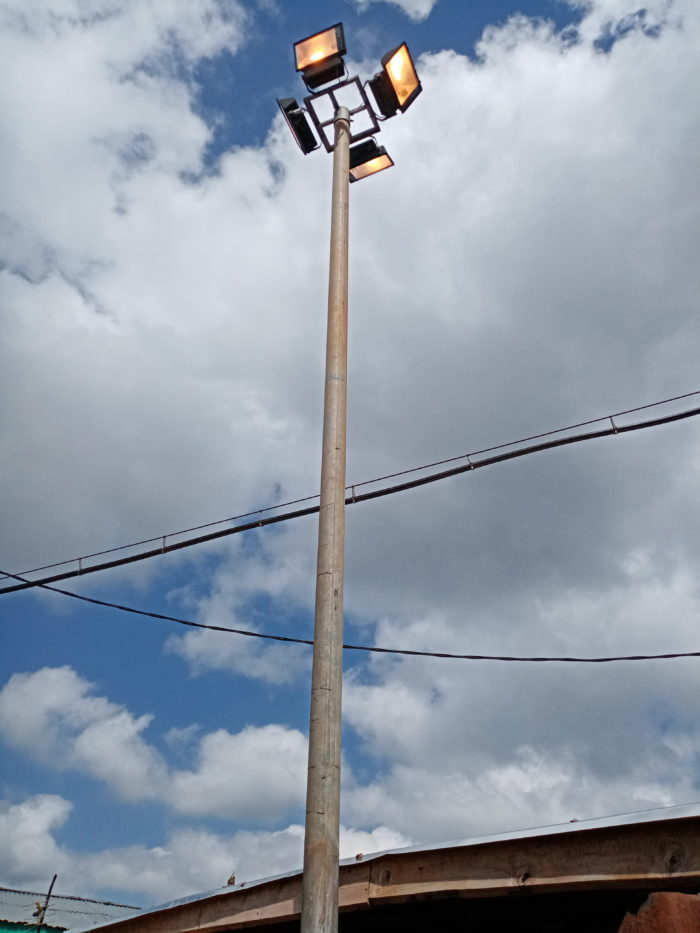
A light stays on during the day, this is due to a malfunction in the sensor.
In some places like Ayany that saw a new installation of security lights by Nairobi Metropolitan Services (NMS) just a few months ago, some of them have already broken down. There are many factors that result in this, but the most common one is due to power surge. Because of how the switch boxes were being vandalized, the authorities opted to connect the lights directly to the main electricity lines. However, the electricity is not well stable, therefore most of the street lights break down due to power surges. Unfortunately, when this occurs it takes a lot of months for the lights to be repaired, in other places, it has taken years for the lights to be repaired, and even when that is done they break down again after a few weeks. Hence the areas are left in darkness despite having the security lights in place.
Uneven distribution of the lights
While some places have security lights almost 5 metres apart, there are other villages like Soweto West and Kianda that only have one or two lights. How this is decided is still unclear but it also shows how some places are still marginalized. I believe it’s right for people to be treated equally and enjoy the same services as everyone else. We are hoping that this data will highlight this high level of inequality and in places where there are few security lights, more will be installed; because the issue of insecurity isn’t determined by an individual’s status quo, it affects everyone and everyone needs to feel safe where they are.
As we await the above issues to be addressed by the relevant offices and offer a lasting solution, we would also like to recognize organizations such Kibera Human Needs who saw the need and launched a project to install solar-powered streetlamps in two villages of Kibera, which has improved lighting of the area at night.
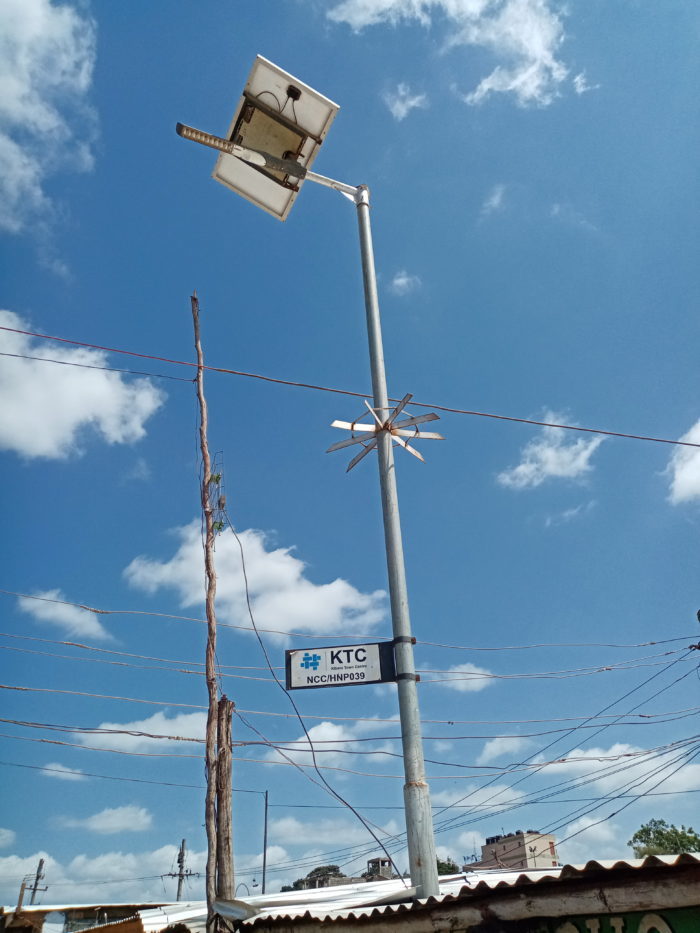
One of the solar-powered streetlamps installed by Kibera Human Needs
In conclusion, fixing the street lighting situation in Kibera will require a lot of partnerships and commitment between residents, local government, and other stakeholders. The best recommendation we have heard from the residents is that many youth groups are open to working with Kenya Power and Lighting (KPLC) and the local authorities to help track and report any arising issue regarding the streetlights. This will help in planning regular maintenance of the streetlights and will also work towards the prevention of vandalism of the electrical cables and light bulbs. The residents need to be involved in all street light projects in order to create a sense of ownership-this will instill a huge sense of responsibility and will prove helpful in the long run.
by: Zack Muindre January 11th, 2018 comments:
As the year 2018 has just began, everyone is busy writing resolutions, some reviewing what worked last year and what they need to change while others are writing new resolutions for the year. We at Map Kibera also took time to reflect on how the year 2017 was for us in terms of the work that we were able to do.
Security mapping/election monitoring
Una Hakika Project
The year began on a good note with the team in Map Kibera conducting a baseline survey for a project that they would be implementing in Kibera in partnership with the Sentinel Project. The project was dubbed Una Hakika? (Are you sure?), and the aim of the project was to assess and moderate the spread of rumours before, during and after the August election.

Una Hakika launch event at Undugu Ground in Kibera
With the August election drawing near, Map Kibera with the help of 3 students from University of Nairobi and JKUAT who were on internship through the Youth Mappers programme conducted a mapping exercise with the help of local community ambassadors drawn from the Una Hakika project.
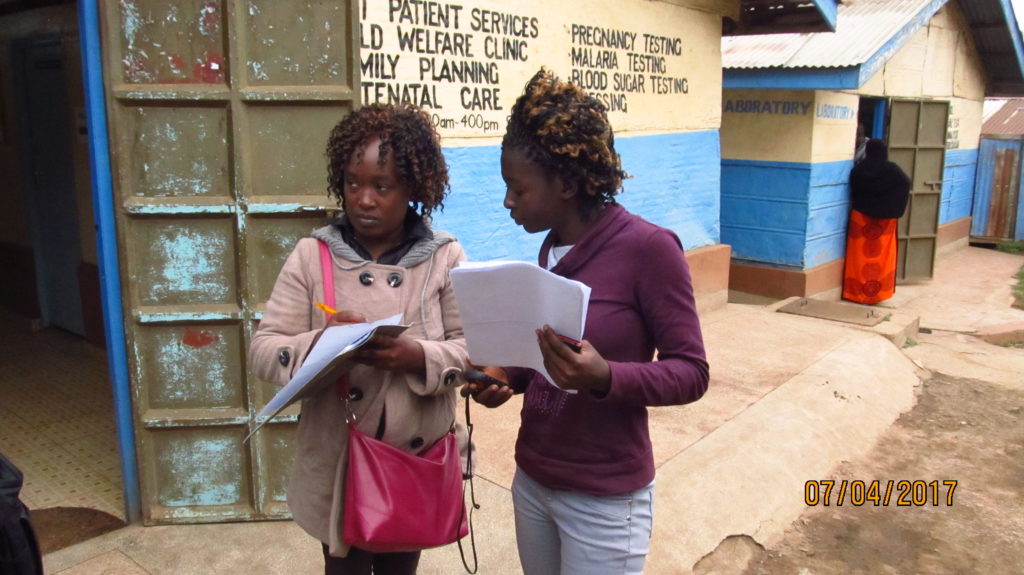
Lucy Fondo (on the left) and Phylister Mutinda collecting data in the field
This was to update the security map that was last updated during the 2013 elections. The printed copies of the maps were distributed to the local administrative officials as well as to NGOs that work in Kibera on peace initiatives.
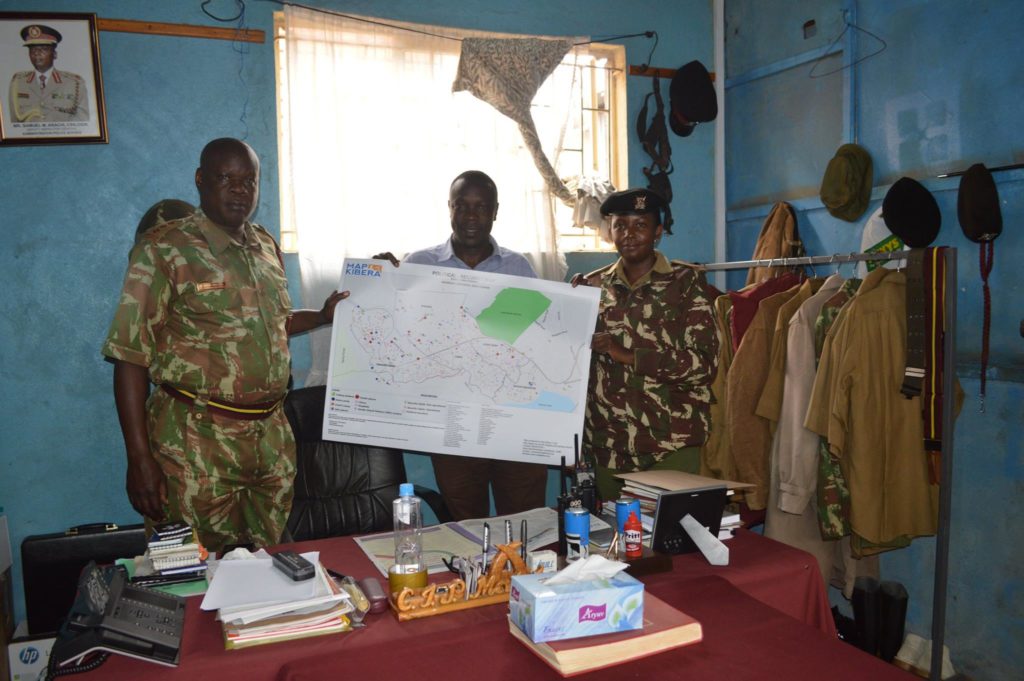
Joshua Ogure issuing a copy of the security map to Adminstration Police commandant
The other copies of the maps were distributed to community members. Read more here. The updated security map was also painted on the wall at a strategic point in Kibera where the community members and visitors would interact with it.
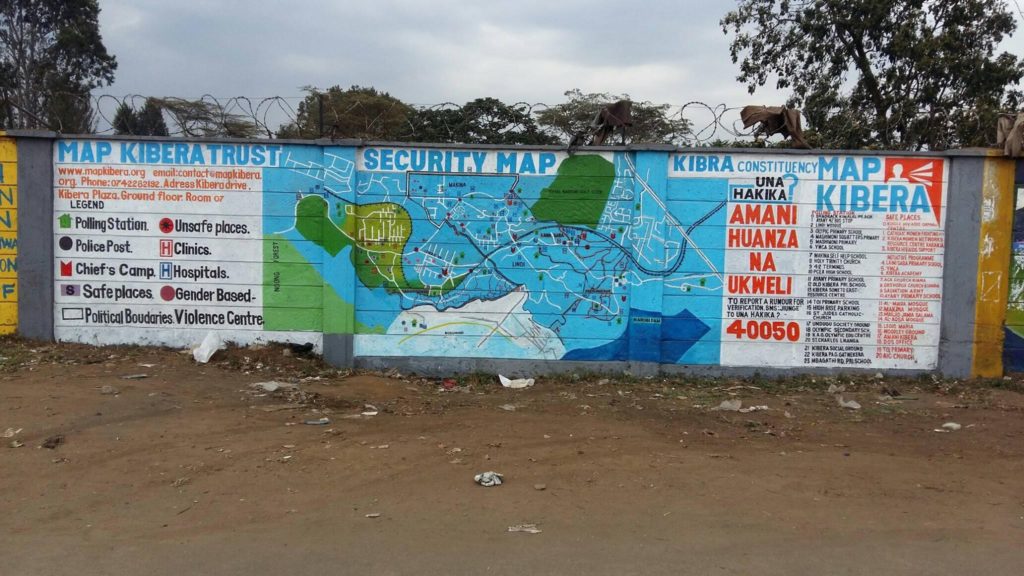
Updated Security map on the wall
During the August 8th election Map Kibera through the Una Hakika project also set up teams on various polling stations to report on the events as they were occurring. This was done through video coverage by the Kibera News Network team. The team was also supposed to report any issues by sending sms to the Una Hakika’s short code 40050.
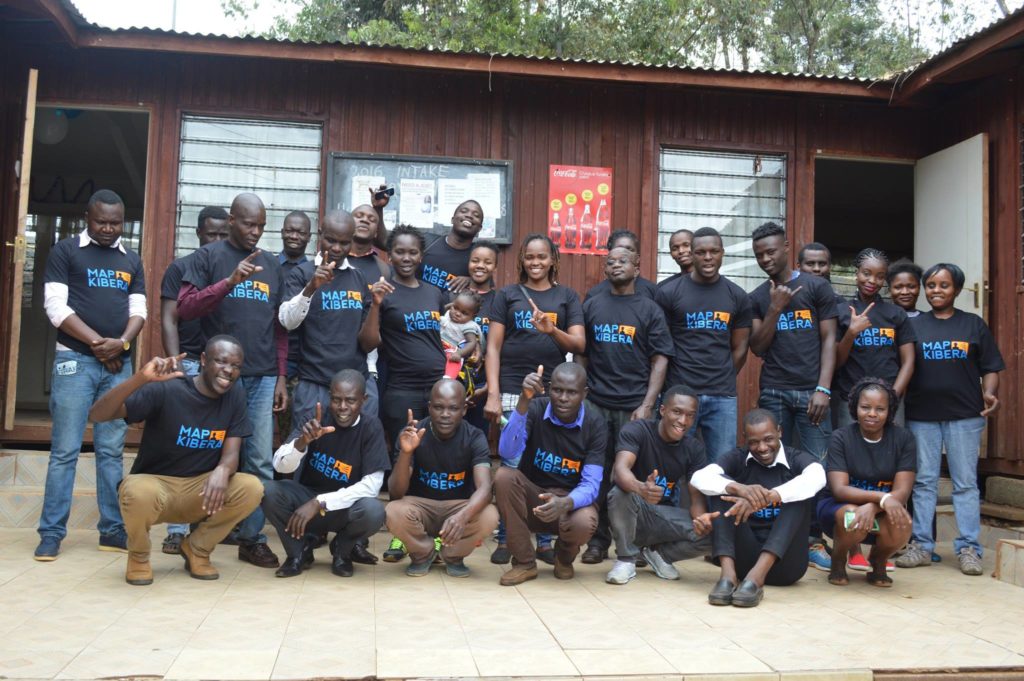
Citizen reporters trained for the elections
Video Coverage of Elections by KNN
The KNN team produced more than 50 videos for both August 8 elections and the repeat October 26 elections. At least one video went “viral” with more than 13,000 views: Kibera Supports Supreme Court Ruling.

A screenshot of the videos produced by KNN during the election period
Repeat election
On 1st of October 2017 the Supreme Court Of Kenya nullified the August 8th Presidential election. The electoral body of Kenya was thereby asked to organize a fresh presidential election. This meant that our work on election monitoring wasn’t yet finished. So we organized and re-strategized to prepare for the fresh election. The period before the new set date for election saw a lot of demonstrations from the opposition team demanding changes on the electoral body before conducting another election. Kibera News Network documented some of these events, and even did interviews with some of the victims of police brutality after violence erupted immediately after Uhuru Kenyatta was declared the winner of the August 8th election. The IEBC set a new date for the repeat election to be 26th October. We monitored these elections afresh just as we did earlier.
Research
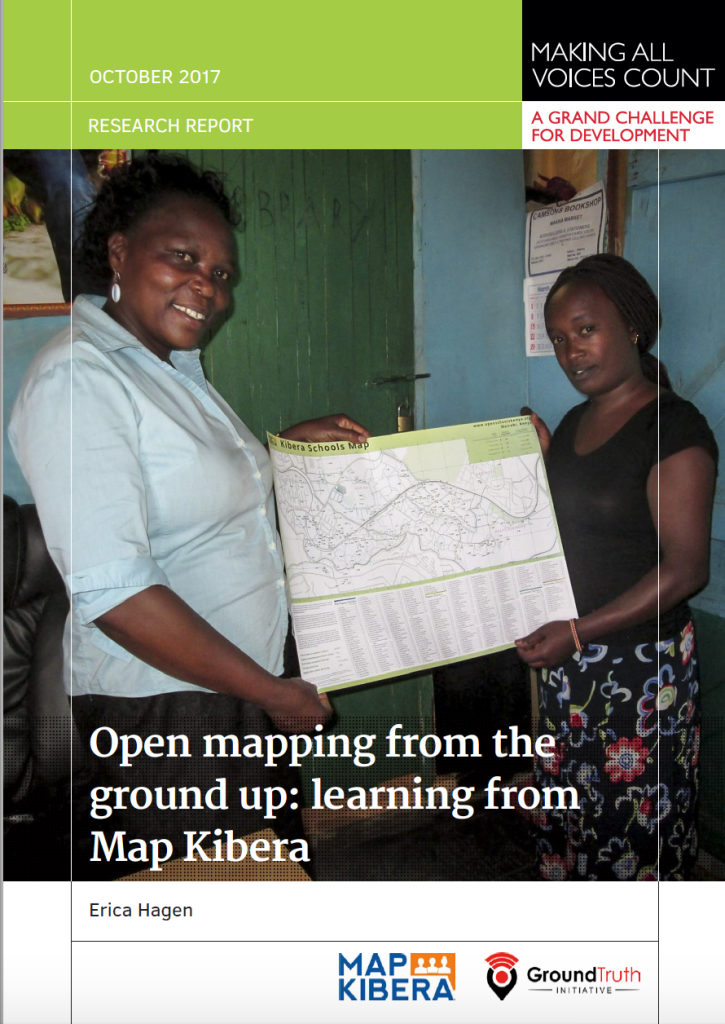 In the same year Erica Hagen, one of the co-founders of Map Kibera, was funded by Making All Voices Count to conduct a research on the impact of the work of Map Kibera in the local community and how the maps are being used by various local organizations, community based organizations, government offices and the community members. Key outcomes were that local officials had used our education maps to reach out to informal schools, build networks and extend resources to these schools. NGOs had also used other maps by Map Kibera to locate resources such as water and sanitation facilities. The research report can be read here.
In the same year Erica Hagen, one of the co-founders of Map Kibera, was funded by Making All Voices Count to conduct a research on the impact of the work of Map Kibera in the local community and how the maps are being used by various local organizations, community based organizations, government offices and the community members. Key outcomes were that local officials had used our education maps to reach out to informal schools, build networks and extend resources to these schools. NGOs had also used other maps by Map Kibera to locate resources such as water and sanitation facilities. The research report can be read here.
Sharing, Participating, Collaborating
The year 2017 also saw Map Kibera being recognized and invited to attend various international and national events to share about their work. Some of the meetings were: the High-Level Meeting on Data for Development in Africa held by the Kenya Government and Global Partnership for Sustainable Development Data (GPSDD); Buntwani 2017 organized by Open Institute, Making All Voices Count, Dlad and Data Zetu in Dar es salaam; the Data Pop course at UN Headquarters in Nairobi, and a radio interview at IQRA FM.
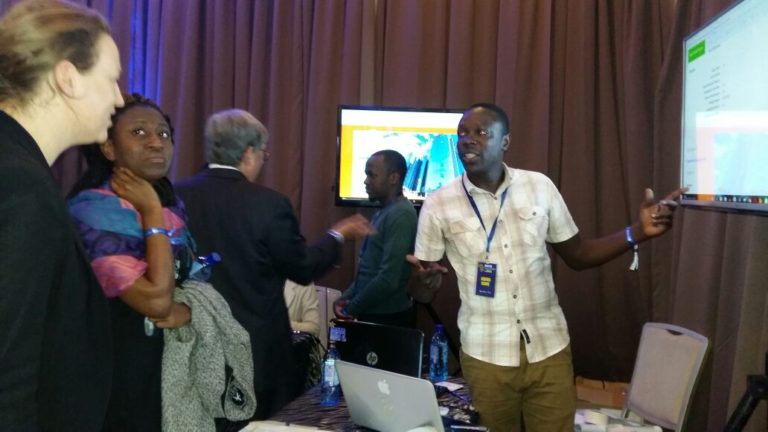
Joshua doing demonstration about Map Kibera and the open schools project at the High level meeting.
 ICT4D
For the second consecutive year Map Kibera has been invited to speak at the ICT4D conference. This year’s conference was held in Hyderabad, India and the theme for the conference was from innovation to impact. Zack Wambua represented the organization at the conference where he shared the impact of the Open Schools Kenya project. Zack also had an opportunity to visit one of the local organization Hyderabad Urban Lab to learn more about the work that they are doing around community participatory mapping in Hyderabad.

Zack Wambua at the ICT4D conference.
 State of the Map (SOTM) AFRICA
This was the first ever SOTM event to be held in Africa, and Map Kibera being one of the oldest users of OpenStreetMap in Africa were invited to share about their work on community mapping, a model that has been borrowed by many groups and organizations that use OSM. Joshua Ogure the project manager of Map Kibera travelled to Kampala, Uganda to represent the organization at the event. Read more here  http://www.mapkibera.org/blog/2017/07/21/my-experience-at-the-first-state-of-the-map-africa/
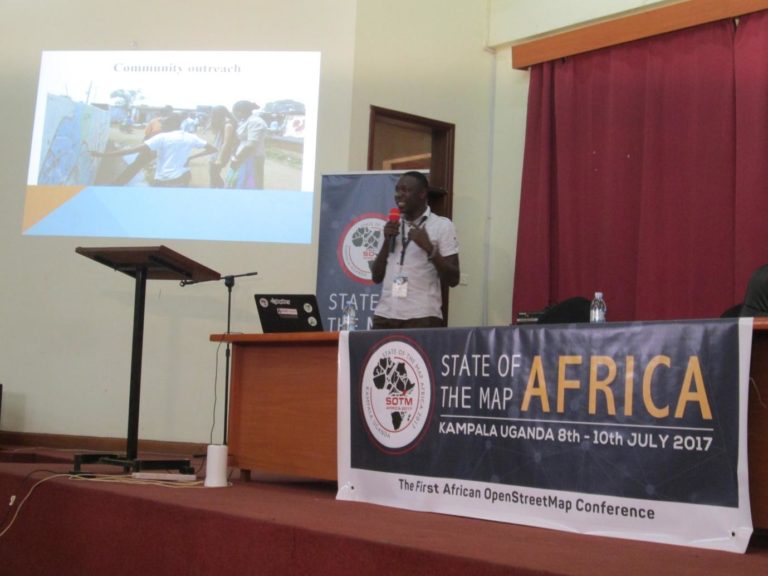
Joshua Presenting Map Kibera at SOTM Africa Kampala
SOTM Tanzania
After the successful SOTM Africa event, OSM teams in Tanzania led by Crowd2Map and Ramani Huria organized SOTM Tanzania. the event took place in Dar Es Salaam. Map Kibera was again called to assist with the planing of the event and also to share about their work during the conference. Zack Wambua travelled to Dar to represent the organization at the conference.

A group photo of all the attendees at SOTM Tanzania
Open Schools Kenya
In 2017Â Map Kibera kept up with changes to the Open Schools Kenya data. We along with our interns checked if the schools were still in the same location and if they had moved, we collected coordinates of their new location and updated the details on the site. We were also able to update school populations (for both teachers and students), changes in school management as well as any other co-curriculum activities that are offered in the schools. This was followed by an update to the website, where we added a search by location filter which enables you to view the schools’ data in both Kibera and Mathare, the two locations that we have rolled out the OSK work. Look for more changes and additional locations in OSK in 2018!
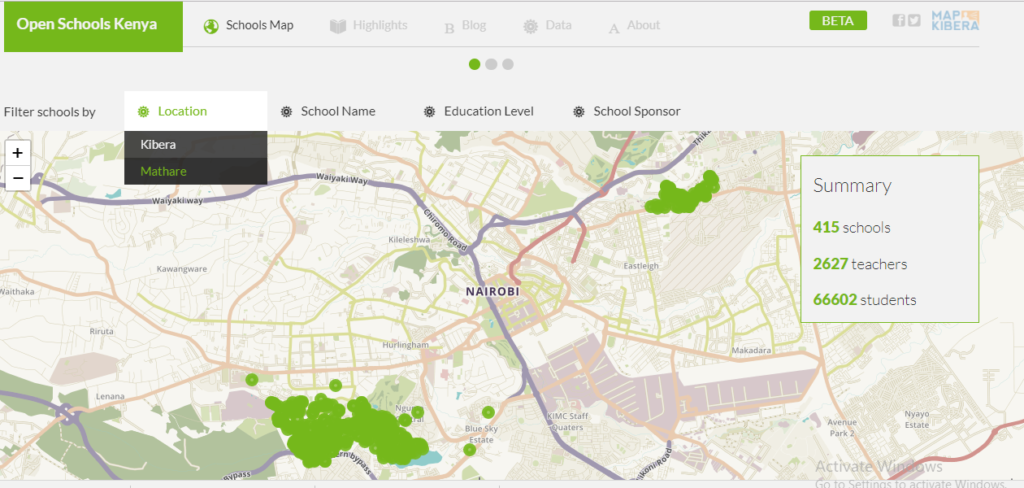
A screenshot of the updated Open Schools Kenya website with the new search by location feature
by: Steve Banner August 18th, 2014 comments:
A Daily Diary post by Map Kibera team member, Steve Banner
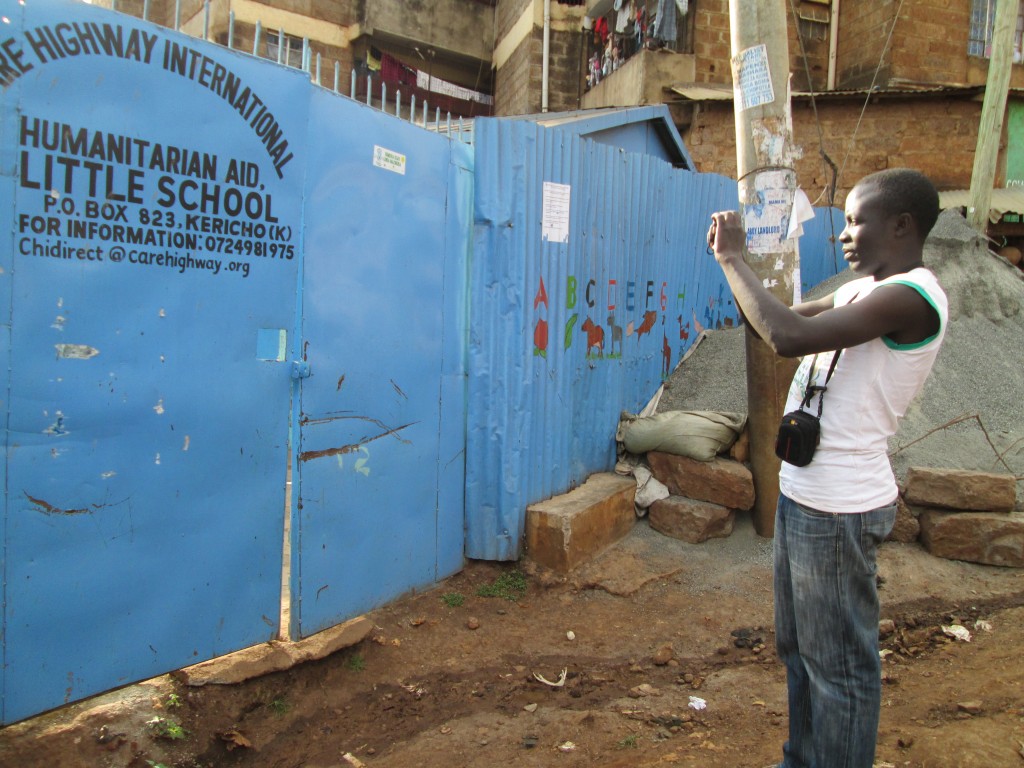
Steve photographs a school for the Open Schools website
Pictures tell a lot, probably too much for some head teachers in Kibera. They won’t allow anyone to take them in their compound before you explain in detail why you have to take photos, what you intend to do with them and of course how they stand to benefit. Before you pull your digital camera out of your pocket, and press anything, the head teachers, directors, or teachers in charge have a number of questions for you to answer. Forget the journalistic five W and H, theirs probably double or even triple that of journalists.
Me, and my colleague Zack met our first questions at Kicoshep School, where the head teacher wondered why a lot of research was being done in Kibera and what the impact of all these research would be. We took her through the details of the project that entailed collecting new data and coming up with a website that will bring together all the educational facilities in Kibera, and how, not only her school, but all the schools in Kibera stood to benefit from the project outcome. She agreed to help fill the form we had, but then she sent us to their headquarters near Wilson airport to get permission to take photos in her school.
No shutter was going to be pressed at Shofco School for Girls either. Explanation given was that there are strict rules on photo taking in and around the school. Shutter was pressed at Bethel school, but not until after we had spent two hours trying to convince the head teacher, her deputy and other two teachers who had many questions to ask, including some in vernacular language that none of us could understand. They argued that since we as Map Kibera are the ones who will host the website, Map Kibera stood to benefit more than them, citing past examples where organizations collected data and nothing was ever seen or heard of them again. They were keen to know the most immediate benefit that they’ll see – and fell just short of asking to be paid for the information they were to give. But just when we were giving up on them, they gave in to our request.
Otherwise, I was free to slide the exposure of my Canon and turn on my flash sensor where I felt necessary in all other schools, which was both fun and educative in equal measure.
Every moment I had my lens focused on a signpost, school compound or classroom, most of which were in a very poor condition, I felt like I was doing something that the Kenyan government had failed in: giving the schools a voice to speak on the challenges they face. For instance, some school directors pointed out that the government is not very keen in improving education within the slum itself, and is only doing so in the schools that are on the outskirts of the slum. So by me being there documenting the facilities with my camera, I felt that I was indirectly offering a solution to the problems facing school going children in Kibera slums.
So, as I switched off the camera, I felt an inner satisfaction that I had done what many people, government officials included, had failed to do to the schools in Kibera, and when we’ll see improvement in education within Kibera as a result of the online education directory, my happiness will be complete.



















